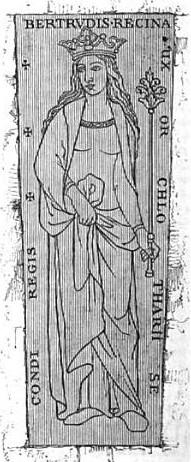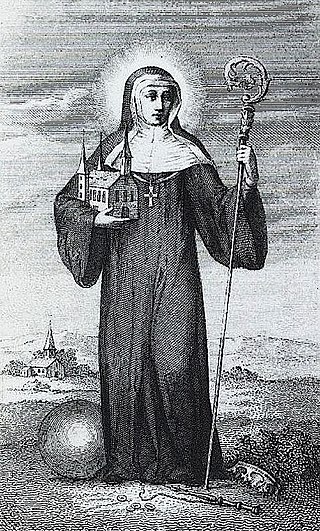Related Research Articles

Year 741 (DCCXLI) was a common year starting on Sunday of the Julian calendar. The denomination 741 for this year has been used since the early medieval period, when the Anno Domini calendar era became the prevalent method in Europe for naming years.

Year 783 (DCCLXXXIII) was a common year starting on Wednesday of the Julian calendar. The denomination 783 for this year has been used since the early medieval period, when the Anno Domini calendar era became the prevalent method in Europe for naming years.

Year 721 (DCCXXI) was a common year starting on Wednesday of the Julian calendar. The denomination 721 for this year has been used since the early medieval period, when the Anno Domini calendar era became the prevalent method in Europe for naming years.
Himiltrude was the mother of Charlemagne's first-born son Pippin the Hunchback. Some historians have acknowledged her as the wife of Charlemagne, however, she is often referred to as a concubine.

Bertrada of Laon, also known as Bertrada the Younger or Bertha Broadfoot, was a Frankish queen. She was the wife of Pepin the Short and the mother of Charlemagne, Carloman and Gisela, plus five other children.

William of Gellone, the medieval William of Orange, was the second Duke of Toulouse from 790 until 811. In 804, he founded the abbey of Gellone. He was canonized a saint in 1066 by Pope Alexander II.

Prüm Abbey is a former Benedictine abbey in Prüm, now in the diocese of Trier (Germany), founded by the Frankish widow Bertrada the elder and her son Charibert, Count of Laon, in 721. The first abbot was Angloardus.

Pepin the Short, was King of the Franks from 751 until his death in 768. He was the first Carolingian to become king.
Martin was the count of Laon in the late second half of the 7th century.

Gisela was a Frankish princess and abbess. She was the daughter of Pepin the Short and his wife Bertrada of Laon. She was the sister of Charlemagne and Carloman.
Hugobert was a seneschal and a count of the palace at the Merovingian court during the reigns of Theuderic III and Childebert III. He was a grandson of the dux Theotar, and it is assumed, but not proven, that his father was Chugus, who in 617 became mayor of the palace of Austrasia. The juxtaposition of names in the Vita Landiberto episcopi Traiectensis may imply a relationship between him and the family of Saint Lambert.

Bertrada, also called Berthe or Bertree, is known to be the mother of Charibert of Laon, with whom she is co-founder and benefactor of the Prüm Abbey. They founded the abbey in 721.
Bertrade (French) or Bertrada (Latin) is a feminine given name derived from Proto-Germanic roots reconstructed as *berht ("bright") and *rād.
Theoderic IV was a Frankish noble and royal missus.

Bertrude, Countess of Vermandois was a Countess of Vermandois and a Frankish queen consort from 613 to 618. She was married to Chlothar II.

Irmina of Oeren was a saint, founder and abbess of a convent in Oeren, near Trier (Trèves), and co-founder of a convent in Echternach. Hagiographer Basil Watkins states that Irmina's 12th century biography is "unreliable" and it is likely that "legends about her family tree spiralled out of control", but she came from one of the most powerful families in the Merovingian kingdom. She might have been Saint Primina, the daughter of Dagobert I and sister of Saint Modesta. She might have been the daughter of Dagobert II and sister of Saint Adela of Pfalze. Historian Ian Wood stated that Irmina is "traditionally, and probably correctly, identified as Plectrude's mother".
Hardrad was a Frankish count and a leading figure in the conspiracy of Thuringian noblemen against Charlemagne. This conspiracy resulted in many nobles being killed and their property confiscated, leading to the laws concerning the subdued Saxons established in the Diet of Aix of 802-803. Hardrad was a member of the Eastern Frankish aristocracy with extensive land assets and good relations with the Monastery of Fulda, and was likely related to the abbot, Baugulf von Fulda. Little is known about the life of Count Hardrad, even from contemporary Frankish sources. In 771, the Cartulary of Lorraine, Abbey Gorze, identified a deceased Hardrad, father of Ratard, who could have been the father or grandfather of the younger Hardrad. It is the same with two other occurrences, one of which is in 746 in Echternach and the other in 721 in Prüm, in which Bertrada of Laon and her father Charibert, the maternal grandfather of Charlemagne, are mentioned.
Chrodbert was a nobleman from Neustria. He was grandson to Chrodbert I, referendary to Clovis II through Chrodbert's son Lambert of Hesbaye. Chrodbert was Lord Chancellor during the reign of Chlothar III, King of the Franks in Neustria, as well as referendary. He was a contemporary of Ansbert of Rouen, who was also a Lord Chancellor to Clotaire III. Chrodbert was mentioned as Count palatine on 2 October 678.
Charibert de Haspengau (555–636) was a Frankish nobleman, possibly a comes. The identity of his parents is uncertain, though he is believed by some to be the son of King Charibert I of Paris. Charibert is described as Charibert nobilis in Neustria. No other information is available other than descriptions of his grandchildren, who are described as having "high rank and worthy of significant positions" within the palace.

Gomentrude, also Gomatrude, Gométrude, or Gomatrudis, was a Frankish queen consort by marriage to king Dagobert I. It is possible that Gomentrude was descended from Ragnacaire, king of the Franks in Cambrai, through his son Magnachaire, Duke of the Franks. She was the younger sister of queen Sichilde, third wife of King Clotaire II. Their brother was likely lord Brodulf, who tried to defend the rights of his nephew on the kingdom of Aquitaine against the ambitions of Dagobert I.
References
- ↑ "Bertrade de Laon, Queen of the Franks", The British Museum
- ↑ Haubrichs, Wolfgang (1979). Die Kultur der Abtei Prüm zur Karolingerzeit. Röhrscheid. p. 31. ISBN 978-3792804018.